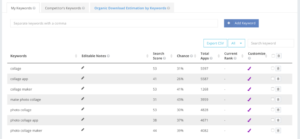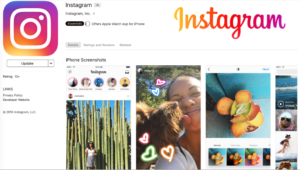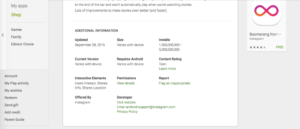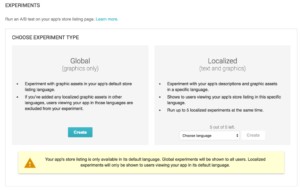Incipia blog
Differences Between Optimizing Apps for the App Store vs Google Play Store
This post was originally featured as a guest article on the Mobile Action Blog.
While the app stores of both Apple and Google share many similarities, there are also some significant differences in how each operates, as well as how to perform ASO for each store. Today’s post will cover some of the main differences between the App and Google Play Stores and provide several ASO tactics, tailored specifically for each app store.
Differences in the Keyword Ranking Algorithm
Both Apple and Google use keywords from an app’s developer name, title and in-app purchases (exact match only for Apple) when determining which user searches an app is eligible to show for. Google also pulls keywords from an app’s full and short description, while Apple uses the iTunes Connect keywords space, and sometimes competitive apps and the category name, with keywords found in an iOS description having no influence on keyword rankings.
Both algorithms are highly influenced by the number of downloads an app receives, and moreover the download velocity (i.e. 10,000 downloads in one day will boost rank significantly higher than 10,000 downloads over the course of one week), and both algorithms scramble and combine individual words found in an app’s listing in order to identify eligible two or more word-long keyword phrases to rank an app for.
Yet, while Apple’s algorithm seems to consistently improve ranking for keywords found in an app’s title (with the limit recently reduced from 255 to 50 characters) Google conversely appears to purposefully reduce rank for non-branded keywords found in an app’s title, possibly as a reproach for attempting to force ranking on keywords.
Apple’s algorithm is also rumored to have begun recently (as of summer, 2016) favoring apps that produce higher revenues through in-app purchases, likely because promoting apps that generate more revenue is a way for Apple to increase its earnings from the App Store while still providing users with a quality experience (i.e. if users are willing to spend money on something, it can be inferred that they are having a positive experience).
Differences in the App Listings
While Google is experimenting with an Apple-like app preview layout, for now apps that show in search results for Google display only a title, icon, developer name and rating; apps that return for a keyword search in the App Store display all the aforementioned elements that Google Play apps do, along with the total number of (current) ratings and either a preview video and first screenshot or the first two screenshots.
Ratings are an area in which Google and Apple differ as well, with Google showing an interval estimate of total downloads and only one aggregate rating, while Apple shows users the reviews and rating from an app’s most recent update by default, with aggregate, all-time available in the app’s product page.
Google also allows developers to add an 80 character short description and a feature graphic, which is a 1024 x 500 sized banner that appears at the top of an Android app store listing, while Apple allows select apps to upload promotional art and even more exclusively, a custom background.
Both stores have a concept of an editor’s choice, while Google gives some developers a “top developer” annotation and Apple has the “essentials” honor.
With the launch of iOS 10, Apple now also supports iMessage apps and recently began allowing apps to show in the App Store before they have officially launched, with a “notify me” button instead of a get/buy button (currently piloting with Super Mario).
Perhaps most significant for ASOs is the difference between actively optimizing an app listing between the two platforms. Apple requires a new build to be submitted and approved before making changes to an app’s screenshots, video, title or keywords (descriptions can be changed between builds), but Google allows developers to submit changes immediately and also provides an entire engine devoted to running A/B experimental tests on an app’s listing.
Differences in Data
Apple provides a cohort analysis of user retention for up to 30 days, a dashboard dedicated to showing subscription data (on the heels of its recent focus on increasing the prevalence of subscription-monetized apps) and more robust drill-down capabilities in reporting.
Google provides a treasure trove of trending data, such as install/uninstall numbers by user/device by day, the precise number of current installs and ratings data (see below), but provides a more limited breakdown of acquisition sources, when compared to Apple’s website referrers.
Top Google ASO Best Practices
- Use HTML text formatting for sections and important words/phrases.
- Be careful about using keywords in your app’s title and short description; not only do you only have 30 and 80 characters respectively, but if you use keywords that are not highly relevant, it can backfire in rankings.
- Include both exact phrases (e.g. “anonymous messaging app”) of important keywords and the individual words that make up important phrases (e.g. “anonymous” and “messaging”) multiple times in your app listing.
- Tap into Google’s robust reporting and marketing infrastructure in a couple key ways:
- Get a breakdown of your app’s review health, including:
- Review volume and star count over time – determine the impact of optimizing your review flow or launching an update.
- The impact on your app’s rating of functionality (positive or negative with performance compared to your category peers) – zero in on the most crucial items to fix.
- Words commonly used in reviews and the sentiment of those reviews (positive or negative) – determine keywords that people use to describe what they like or dislike about your app.
- Most common keywords used in reviews – learn what “native” keywords people are using to describe your app.
- Always have an experiment running. They are free, easy to set up and analyze, and can yield some great improvements in CVR.
Top Apple ASO Best Practices
- Do not repeat keywords across the title/keywords space, use misspellings, include the word “app” or use plural/singular versions of a word that you already have a singular/plural version of (i.e. do not use “recipe” if you already use the word “recipes”).
- For any keyword phrases that are important to your app, ensure that the relevant areas of your app listing include each individual word of those phrases (e.g. for “photo collage maker,” ensure that you use the words “photo,” “collage” and “maker”).
- Prioritize keywords based on search volume and the ability of your app to rank for those keywords by using an ASO tool like Mobile Action to determine keyword search volume and track keyword ranking; swap keywords that don’t work out with other keywords when submitting new builds.
- Use your keywords space as a playground to test out keywords you think are high value, and then move the words that your app gains the best rank for (target top 10, top 50 and top 100) into your app’s title.
Happy optimizing!
This post was originally featured as a guest article on the Mobile Action Blog.
That's all for now, folks! Be sure to bookmark our blog, sign up to our email newsletter for new post updates and reach out if you're interested in working with us.
Incipia is a mobile app development and marketing agency that builds and markets apps for companies, with a specialty in high-quality, stable app development and keyword-based marketing strategy, such as App Store Optimization and Apple Search Ads. For blog/video or speaking requests, business or press inquiries please contact us or send an inquiry to hello@incipia.co.
Categories
Tags:
- A/B testing
- adjust
- advertising
- adwords
- agile
- analytics
- android development
- app analytics
- app annie
- app development
- app marketing
- app promotion
- app review
- app store
- app store algorithm update
- app store optimization
- app store search ads
- appboy
- apple
- apple search ads
- appsee
- appsflyer
- apptamin
- apptweak
- aso
- aso tools
- attribution
- client management
- coming soon
- design
- development
- facebook ads
- firebase
- google play
- google play algorithm update
- google play aso
- google play console
- google play optimization
- google play store
- google play store aso
- google play store optimization
- google uac
- google universal campaigns
- idfa
- ios
- ios 11
- ios 11 aso
- ios 14
- ios development
- iot
- itunes connect
- limit ad tracking
- ltv
- mobiel marketing
- mobile action
- mobile analytics
- mobile marketing
- monetization
- mvp
- play store
- promoted iap
- promoted in app purchases
- push notifications
- SDKs
- search ads
- SEO
- skadnetwork
- splitmetrics
- startups
- swift
- tiktok
- uac
- universal app campaigns
- universal campaigns
- user retention
- ux
- ux design



